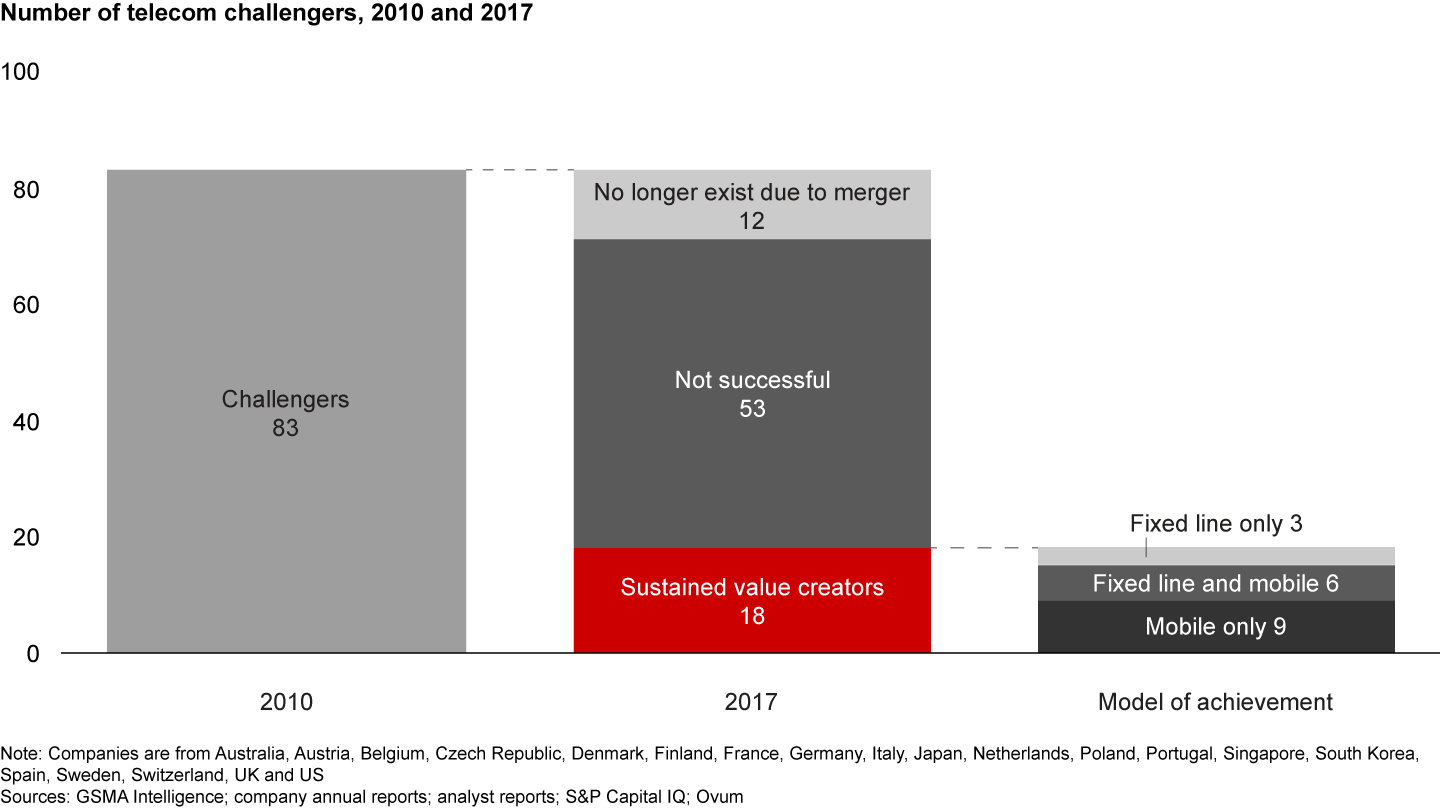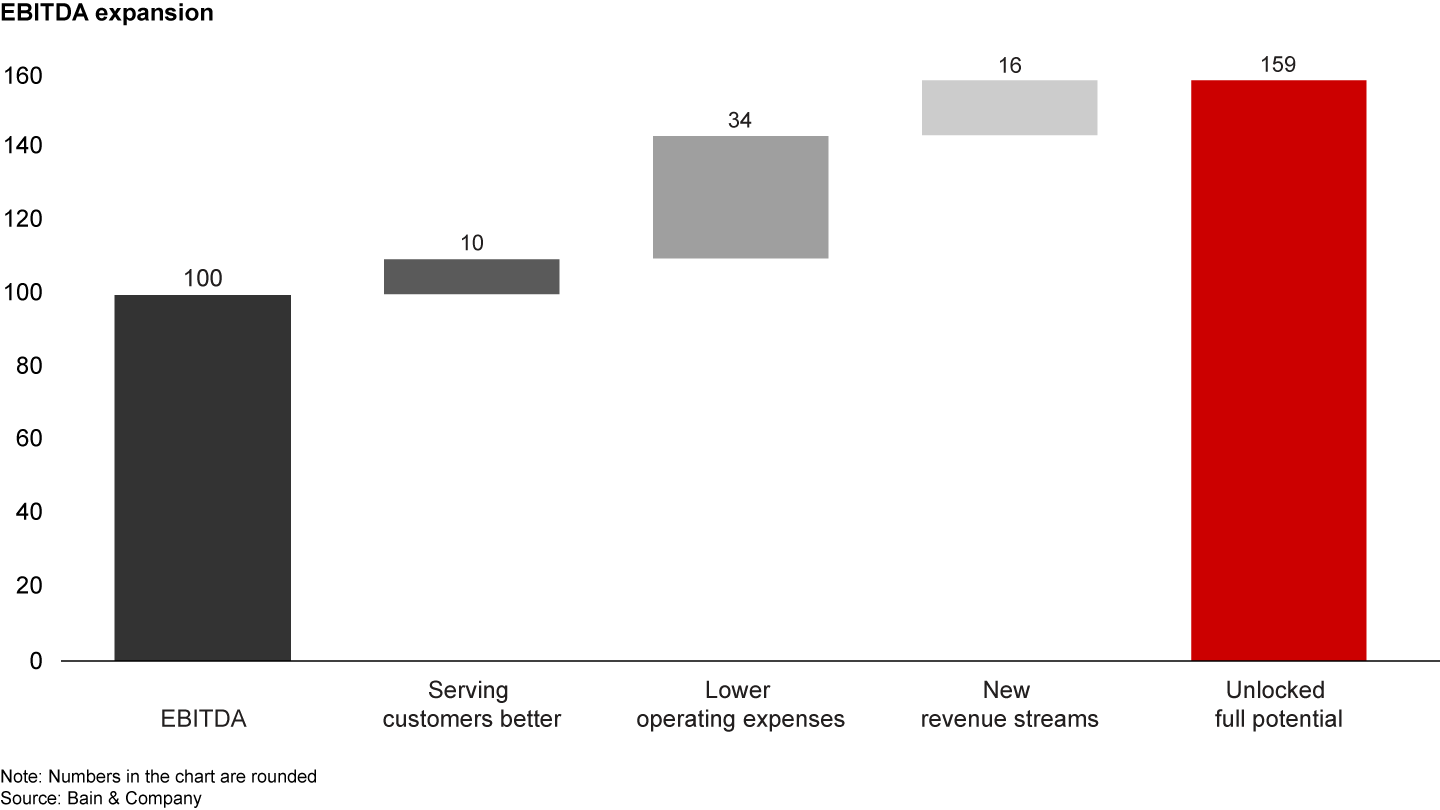Brief

Auf einen Blick
- In recent years, few challengers have successfully taken on telecom incumbents. Only one-fifth of challengers have increased both revenue and free cash flow since 2010.
- Winners make clear choices on where to compete. They deliver value in customer episodes, keep their operations lean, deploy capital strategically and use an Agile approach.
- This challenger playbook has become even more critical as telecom enters a new phase of competition triggered by digital disruption.
In recent years, the telecommunications industry has gone through a period of consolidation and convergence. Many challengers have found themselves bought out by the very incumbents they had once hoped to dislodge. Established companies that formerly specialized in fixed line, broadband, cable or mobile now provide all those services under one roof. With greater scale and wider scope, these incumbents can invest more in networks and spend more on marketing, enabling them to get even larger and more powerful.
In this bigger-is-better environment, a handful of competitors have flouted conventional wisdom and taken on the incumbents. These select challengers have not only survived, they have thrived. They have grown profitably and created value consistently for their shareholders, using strategies and execution playbooks that hold powerful lessons for all.
Just how rare is success for telecom challengers? Of the 83 contenders in 20 markets analyzed by Bain & Company, only 18 of them (or 22%) have grown both their revenue and free cash flow in absolute terms and increased their share of the general profit pool from 2010 to 2017. In other words, most challengers have not gained ground; they have marked time (see Figure 1).

While there is no one recipe for success, the challengers that stand out on performance have embraced five key principles—all underpinned by a customer-centric approach and a spirit of insurgency.
- They make clear choices on “where to play” across customer segments, channels, products and geographies. They aim for scale and differentiation in select battlegrounds and stay away from markets where they do not think they can gain an edge.
- They deliver “more for less,” by developing tailored, cost-effective value propositions for specific customer episodes.
- They keep their operations lean, supported by a radically simplified and digital operating model
- They deploy capital as a strategic weapon. They invest wisely, channeling scarce resources to specific battlegrounds. Where appropriate, they form partnerships and make acquisitions.
- They develop an effective leadership team and use an Agile approach. They sustain an insurgency mission and a “challenger’s mindset,” avoiding silos, corporate politics, bureaucracy and lethargy.
This challenger playbook has become even more critical as the telecom industry enters a new phase of competition triggered by digital disruption. Thanks to new technologies and new approaches—among them, cloud-based storage and data processing; scalable, modular IT; and Agile work processes—challengers can compete effectively with less capital.
For challengers that master this new competitive environment, the opportunity is huge. Our experience shows that telcos can improve EBITDA by about 60% within three to five years—by increasing revenues from existing customers, generating new revenue streams from new products, lowering operating expenses, and spending capital more efficiently. A new breed of challenger is ascendant. Those that succeed will be the ones that fully embrace the challenger playbook and adapt it for a digital age.
Winning in an era when size matters less
Throughout the evolution of telecom competition, one premise was always believed to be true: it pays to be big. Scale players can afford the large amount of capital necessary to invest in the next generation of network technology and IT infrastructure. In addition, they can generate sufficient cash flow to fund the substantial marketing and sales efforts to build a national brand.
However, size alone is no guarantee of success. In fact, it has not been for a long time. Our analysis across 20 markets shows that only 15% of incumbents have won both market share and increased free cash flow since 2010. Most of the telecom Goliaths have been struggling in recent years, with many of them managing for cost while suffering customer defections and hits to their top and bottom lines.
On the other hand, challengers have not had it easy, either. Multiple players have stayed stagnant. Some grew for a few years, then drifted in profitability and sales. Others have invested aggressively in revenue growth, but with limited returns for their shareholders. Only a few companies have consistently created value.
Miguel Simoes de Melo, a partner with Bain's Telecommunications practice, discusses how challengers have embraced five key strategic principles to win against larger players in the market.
Winning challengers have delivered value in one of two ways. The first group, which includes T-Mobile in the US and Unitymedia in Germany, have excelled at “customer-led growth.” They target a broad spectrum of customers and manage to simultaneously increase market share, profitability and free cash flow. The second group, which includes Vodafone Hutchison Australia and the UK company Three, has pursued “profitability-first growth.” They increase profits and free cash flow, while containing costs and focusing on specific market segments.
Among the winners in the customer-led group are companies that deliver tailored products, such as “all you can eat” fixed-price tariffs and discounted calling and data plans for families. These companies prioritize their investments, focusing on high-volume areas such as mobile broadband for cities, and they excel at customer service, particularly in digital channels.
A new digital reality
Whether they take a customer-led or a profitability-first approach, challengers now face the task of adapting the recipe for success to the new realities of the marketplace. Forward-looking companies are ready to take advantage of several major trends that are reshaping the competitive landscape.
- Changing consumer preferences. Customers are becoming ever more demanding. They expect fast, clear connections; personalized products and plans; and “always available,” round-the-clock digital service.
- The rise of data and artificial intelligence (AI). Telcos can gather and harness more data than ever before. Using AI, they can automate internal and customer-facing processes. With advanced analytics (AA), they can more accurately predict customer preferences.
- The evolution of IT. Thanks to cloud technology, telcos can store and process data more efficiently. Using scalable modular architecture, microservices and open application programming interface (API) technology, they can build apps faster.
- New network technologies. A raft of innovations will allow operators to improve network speed and capabilities, including 5G, software-defined networking and network function virtualization.
- Flexible operating models. Telcos can adopt Agile ways of working and take advantage of shared IT tools to use talent more effectively.
As they watch these trends unfold, telcos are refining the five principles of the challenger playbook. They are using data-driven insights to augment their understanding of where to play. By applying AA, they can hone their value propositions into even more targeted microsegments, with tailor-made strategies for each niche. Technology can also help challengers keep their operations lean, with an approach that is both simple and digital. With open APIs and new network technologies, they can be more nimble and strategic about the way they deploy capital. With help from shared IT tools, they can further refine their Agile ways of working.
Our experience shows that challengers that follow this new playbook can reap multiple benefits. Much of the potential 60% boost to EBIDTA within five years comes from serving customers better. By providing customers with tailor-made offerings and efficient, digital-first service, companies can increase their Net Promoter Score® by 20 to 30 points. As churn shrinks, the lifetime value of their customers rises. Happy customers are more likely to refer friends and colleagues, thus lowering the marginal cost of acquiring new subscribers (see Figure 2).

Satisfied customers are also inclined to spend more, and microsegmentation means they are more apt to find products that fit their needs. In addition, the new generation of contenders can cut operating expenses even further, by taking a series of steps. They can shift to a digital-first, omnichannel strategy and use AA to predict and preemptively resolve customer needs.
The telecom industry has come a long way from the days when state-owned and state-sanctioned monopolies and oligopolies dominated most markets. In the past decade, challengers, helped by continual advances in technology, have upended the industry, bringing new and improved services and lower prices to consumers. In recent years, however, only a few of these challengers have prospered. Those that have succeeded have excelled at putting into practice the five ingredients of the challenger playbook. The contenders that thrive as telecom enters its next era of competition will be those that adapt the playbook for a marketplace where scale matters less than ever, and a trenchant, customer-centric strategy can carry the day.
Miguel Simoes de Melo is a partner with Bain’s Telecommunications practice and is based in London. Frédéric Debruyne leads the firm’s Telecommunications practice in Europe, the Middle East and Africa and is based in Brussels. Dunigan O’Keeffe is a partner in the Telecommunications practice and is based in San Francisco. Jean-Philippe Biragnet leads the Telecommunications practice in Asia-Pacific and is based in Tokyo.
Net Promoter Score®, Net Promoter System®, Net Promoter® and NPS® are registered trademarks of Bain & Company, Inc., Fred Reichheld and Satmetrix Systems, Inc.


